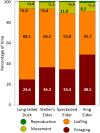Prey availability and foraging activity by tundra-nesting sea ducks: Strong preference for specific wetland types
- PMID: 37745786
- PMCID: PMC10511831
- DOI: 10.1002/ece3.10375
Prey availability and foraging activity by tundra-nesting sea ducks: Strong preference for specific wetland types
Abstract
Wetlands in Arctic tundra support abundant breeding waterbirds. Wetland types differing in area, depth, vegetation, and invertebrate biomass density may vary in importance to birds, and in vulnerability to climate change. We studied availability and use of different wetland types by prelaying females of four species of sea ducks (Mergini) breeding on the Arctic Coastal Plain of Alaska, USA: long-tailed ducks (Clangula hyemalis) and Steller's (Polysticta stelleri), spectacled (Somateria fischeri), and king eiders (Somateria spectabilis). All four species preferred shallow vegetated wetlands versus deeper lakes. The ducks spent almost all their active time feeding, but their occurrence in different wetland types was not affected by the relative biomass density of known prey or of all invertebrates that we sampled combined. Sea ducks strongly preferred wetlands dominated by emergent and submersed Arctophila fulva over those dominated by the sedge Carex aquatilis, despite the much greater number, total area, and invertebrate biomass density of Carex wetlands. The hens depend heavily on local invertebrate prey for protein to produce eggs; thus, their preference for Arctophila wetlands likely reflects greater accessibility of prey in the near-surface canopy and detritus of Arctophila. Such shallow wetlands decreased substantially in number (-17%) and area (-30%) over 62 years before 2013 and appear highly susceptible to further declines with climate warming. Impacts on sea ducks of climate-driven changes in availability of important wetland types will depend on their adaptability in exploiting alternative wetlands.
Keywords: Arctic birds; climate change; eider; long‐tailed duck; thawing tundra; tundra wetlands; wetland invertebrates.
© 2023 The Authors. Ecology and Evolution published by John Wiley & Sons Ltd. This article has been contributed to by U.S. Government employees and their work is in the public domain in the USA.
Conflict of interest statement
None declared.
Figures







References
-
- Alisauskas, R. T. , & Devink, J.‐M. (2015). Breeding costs, nutrient reserves, and cross‐seasonal effects: Dealing with deficits in sea ducks. In Ducks, Savard J.‐P. L., Derksen D. V., Esler D., & Eadie J. M. (Eds.), Ecology and conservation of North American Sea (pp. 125–168). CRC Press.
-
- Amundson, C. L. , Flint, P. L. , Stehn, R. A. , Platte, R. M. , Wilson, H. M. , Larned, W. W. , & Fischer, J. B. (2019). Spatio‐temporal population change of Arctic‐breeding waterbirds on the Arctic coastal plain of Alaska. Avian Conservation and Ecology, 14, 18.
-
- Andresen, C. G. , & Lougheed, V. L. (2015). Disappearing Arctic tundra ponds: Fine‐scale analysis of surface hydrology in drained thaw lake basins over a 65 year period (1948–2013). Journal of Geophysical Research: Biogeosciences, 120, 466–479.
-
- Bart, J. , & Earnst, S. L. (2005). Breeding ecology of spectacled eiders Somateria fischeri in northern Alaska. Wild, 55, 85–100.
Associated data
LinkOut - more resources
Full Text Sources

